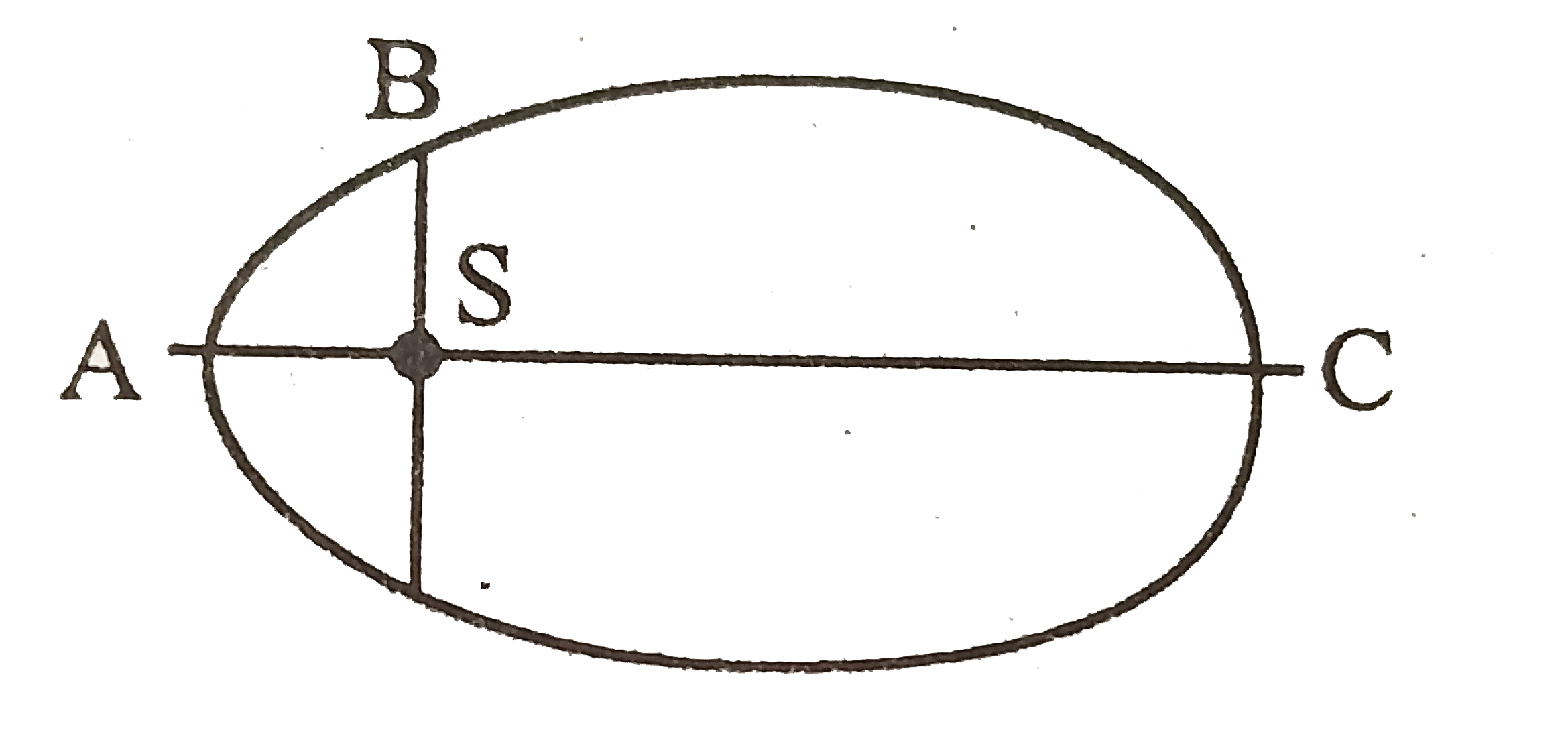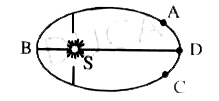The kinetic energies of a planet in an elliptical orbit about Sun, at positions A, B and Care KA,KBandKC respectively. AC is the major axis and SB is perpendicular to AC at the position of the Sun S as shown in the figure. Then
 Solution in Gujrati
Solution in Gujrati
KB>KA>KC
KB>KA>KC
KB>KA>KC
KB>KA>KC
The correct Answer is:D
⇒ Point A is perihelion where the velocity of planet is minimum and point B is Aphelion where the velocity of planet is maximum
K.E. =12mv2
∴K.E.∝v2 ( ∴12 m is constant )
∴KA>KB>KC
Topper's Solved these Questions
- GRAVITATIONBook:KUMAR PRAKASHANChapter:GRAVITATIONExercise:Section - F Questions from Module
Explore 20 Videos
- GRAVITATIONBook:KUMAR PRAKASHANChapter:GRAVITATIONExercise:QUESTIONS PAPER Section - A
Explore 6 Videos
- GRAVITATIONBook:KUMAR PRAKASHANChapter:GRAVITATIONExercise:Section - D NCERT Exemplar Solutions (Long Answer Type Question )
Explore 5 Videos
- LAW OF MOTIONBook:KUMAR PRAKASHANChapter:LAW OF MOTIONExercise:(QUESTION PAPER) SECTION-D
Explore 1 Video
Similar Questions
Two particles of equal mass m move around a circle of radius R under the influence of their mutual gravitational attraction, the speed of each particle with respect to their center of mass will be ..........
View SolutionThe magnitude of gravitational intensity at a point is 0.7 N/kg. What would be the magnitude of the gravitational force on a body of 5 kg mass at this point ?
View SolutionA star like the sun has several bodies moving around it at different distances. Consider that all of them are moving in circular orbits. Letr be the distance of the body from the centre of the star and let its linear velocity be v, angular velocity , ω kinetic energy K, gravitational potential energy U, total energy E and angular momentum I. As the radius r of the orbit increases, determine which of the above quantities increase and which ones decrease. As shown in figure, where a body of mass m is revolving around a star of mass M. Linear velocity of the body,
View SolutionA 70 kg man stands in contact against the inner wall of a hollow cylindrical drum of radius 3 m rotating about its vertical axis with 200 rev/min. The coefficient of friction between the wall and his clothing is 0.15. What is the minimum rotational speed of the cylinder to enable the man to remain stuck to the wall (without falling) when the floor is suddenly removed ?
View SolutionFigure shows a planet in an elliptical orbit around the Sun S . Where is the kinetic energy of the planet maximum?
View SolutionThe kinetic energies of a planet in an elliptical orbit about the Sun, at positions A,B and C are K_(A),K_(B) and K_(C) respectively. AC is the major axis and SB is perpendicular to AC at the position of the sun as shown in the figure. Then
View SolutionFigure showns a planet in an elliptical orbit around the sun S. Where is the kinetic energy of the planet maximum?
View Solutionसूर्य के चारों ओर दीर्घवृत्तीय , b कक्षा में गतिमान ग्रह की स्थितियों A, B और C पर गतिज ऊर्जाएँ क्रमश : KA,KB और KC हैं । AC दीर्घ अक्ष तथा सूर्य की स्थिति S पर SB चित्रानुसार AC पर लंब है । तब -

View SolutionThe maximum kinetic energy of a planet moving around the sun is at a position Sun
View Solutionसूर्य के चारों ओर दीर्घवृत्तीय कक्षा में गतिमान ग्रह की स्थितियाँ A, B तथा C पर गतिज ऊर्जाएँ क्रमशः Kx, Kg और Kल हैं। AC दीर्घ अक्ष है तथा सूर्य की स्थिति पर SB चित्रानुसार दीर्घ अक्ष AC पर लम्ब है । तब-

View SolutionThe planet mercury is revolving in an Elliptical orbit around the sun as shown in the figure. The kinetic energy of mercury will be greatest at

View SolutionThe planet mercury is revolving in an Elliptical orbit around the sun as shown in the figure. The kinetic energy of mercury will be greatest at

View SolutionThe planet mercury is revolving in an Elliptical orbit around the sun as shown in the figure. The kinetic energy of mercury will be greatest at
View SolutionThe planet mercury is revolving in an Elliptical orbit around the sun as shown in the figure. The kinetic energy of mercury will be greatest at

View SolutionThe kinetic energies of a planet in an elliptical orbit about the Sun, at positions A,B and C are KA,KB and KC respectively. AC is the major axis and SB is perpendicular to AC at the position of the sun as shown in the figure. Then

View Solution

